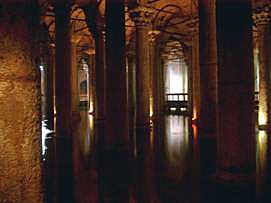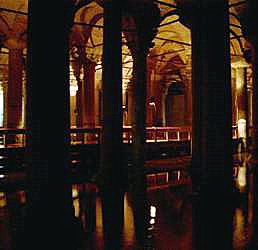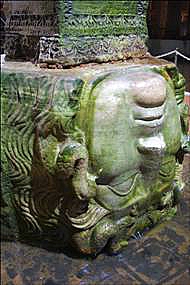After Rome was destroyed by the Visigoths in 410, Emperor Constantine the Great chose a small fishing village on the Bosphorus to become the new imperial capital. This small fishing village was inaugurated as Constantinople, what we now know as Istanbul. The Roman empire based in Constantinople is usually referred to as the Byzantine Empire.
There are many artefacts relating to the Byzantine Empire in
Istanbul, but the Beetle's favourite is the Byzantine cisterns.
If you've seen the James Bond movie, From Russia with Love,
maybe you remember the scene where the redoubtable Mr Bond is
rowing in a small boat through a forest of marble columns – this
was filmed in Yerebatan Saray Sarniçi. 
This cistern is thought to have been built in 532 AD, using marble
columns recycled from Greek ruins in and around the Bosphorus. The
water was routed from reservoirs around the Black Sea and
transported via the Aqueduct of Valens. It was used as a backup for
periods of drought or siege for the Great Palace. Historians
believe that the cisterns were left largely untouched by the
Ottomans, who preferred running, not stagnant, water, and the
stored water ended up being used to water the Topkapi Gardens. The
cistern was later left to collect silt and mud until it was cleaned
by the Istanbul Municipality and opened to the public in 1987. 
It is just one of many cisterns underneath modern day Istanbul, and
the largest at 70 x 140 metres, (or 2.4 acres), and can hold 80,000
cubic metres – over 21 million US gallons). It is very grand and
there are twelve rows of 28 columns each making an impressive total
of 336 marble columns and you walk between the columns on a large
boardwalk. At the far end of the walkway are two large Medusa
heads in the north-western corner, one inverted and the
other on its side; according to mythology, placing her this way
caused her to turn herself into stone. Another theory is that
turning her upside down neutralises her powers. There are some huge
fish too in the water whose function is to aerate the water (and
feed on tourists' handouts). There are signs giving details of
classical concerts that take place in the cisterns. The Basilica
Cistern was restored in 1980 for visitors.
in the north-western corner, one inverted and the
other on its side; according to mythology, placing her this way
caused her to turn herself into stone. Another theory is that
turning her upside down neutralises her powers. There are some huge
fish too in the water whose function is to aerate the water (and
feed on tourists' handouts). There are signs giving details of
classical concerts that take place in the cisterns. The Basilica
Cistern was restored in 1980 for visitors.
There's also a café with wobbly metal tables and chairs and orange lighting adding to the subterranean feeling.
Yerebatan is in Sultanahmet Square, at the north-eastern end of the Hippodrome, just off Divan Yolu, and across the street from Ayasofya (Hagia Sophia). Opening hours: Daily 0900-1700. Admission: $3.50.
